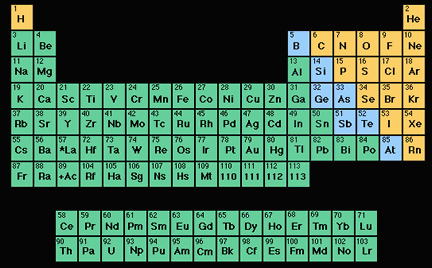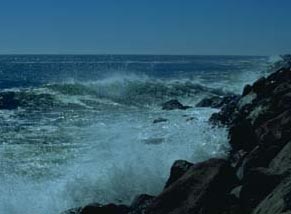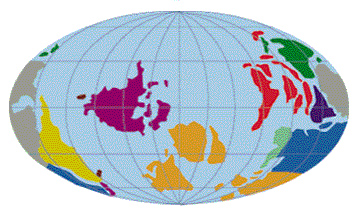Click on image for full size
Image from: Kentucky Coal Education Web Site
Iron Ore Deposits
Eventually,
photosynthesis by the earliest forms of
plant life (a form of life capable of feeding itself instead of feeding off of others) began to produce significant amounts of oxygen. One important thing to know about oxygen is that it likes to attack other
elements and attach itself to them. Iron, in particular, is easily attacked by oxygen.
Other forms of heterotrophic early life (life forms which eat things outside themselves) had been producing waste products such as iron, which built up in the early ocean. As oxygen began to be produced, a peculiar thing happened. Large amounts of iron which had accumulated in the early ocean were attacked by the accumulating oxygen. When oxygen reacts with iron, iron ores are produced. Today, iron ores are taken out of the ground by miners, and the iron they contain is used by human beings to make lots of things.
For a billion years, the oxygen produced by early plant life attacked leftover iron in the ocean, and huge deposits of iron ores were laid down at the bottom of the sea. This activity took place between 3.5 and 2.5 billion years ago. Iron ores mined today in the United States, Australia, and South Africa, are part of the huge deposits laid down at that time. Once the oceans were swept clean of iron, then the oxygen could begin to build up in the atmosphere, and respiration
by sophisticated life forms could begin in earnest. It took a billion years for this process to complete. When it was finished, it closed the period in the history of the Earth which we call the Archean
.
You might also be interested in:

There are many different kinds of plants. Some have big leaves. Some have small leaves. Some even have flowers. All plants make their own food. When sunlight hits the leaves of a plant, photosynthesis
...more
Over a very long time, gradual changes in the earliest cells gave rise to new life forms. These new cells were very different from earlier cells because they were able to get their energy from a different
...more
An element (also called a "chemical element") is a substance made up entirely of atoms having the same atomic number; that is, all of the atoms have the same number of protons. Hydrogen, helium, oxygen,
...more
The first beings were probably much like coacervates. As a group, these bacteria were heterotrophic , meaning that they ate food which came from somewhere else. Because there was virtually no oxygen in
...more
Once the Earth began to cool, water vapor, one of the volatiles, began to condense and form an ocean. According to the Goldilocks theory, Earth is at just the right distance from the sun for the temperature
...more
You may have heard of photosynthesis. That's where a plant uses energy from the Sun's rays to make its own food. The opposite of photosynthesis is called respiration. The difference is that respiration
...more
About 2.5 billion years ago (BYA) oxygen began to build up in the atmosphere. Life used this change to developed eukaryotic cells. These are cells which include a nucleus. Both heterotrophs (early animals)
...more
The Archean is the name of the age which began with the forming Earth. This period of Earth's history lasted a long time, 2.8 billion years! That is more than half the expected age of the Earth! And no
...more














